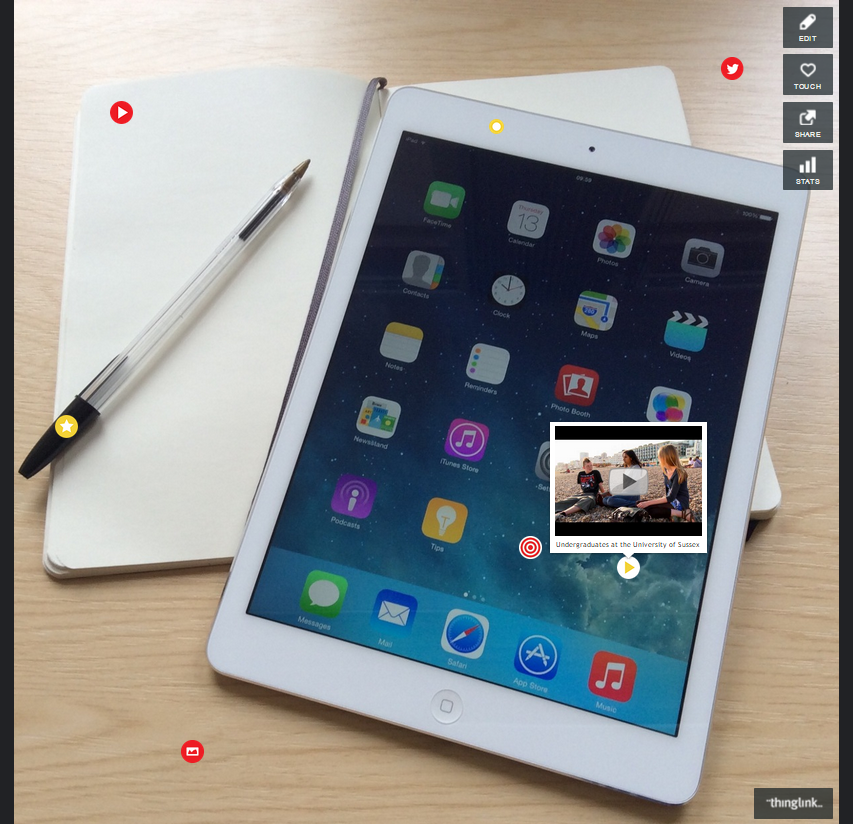What is ThingLink?
 Available on both iOS and Android, ThingLink is a free app that allows you to create and share engaging interactive images. With ThingLink users can overlay rich media tags onto an image or diagram and embed links and multimedia from across the web as well as text, images and recordings, allowing for many different kinds of resources to be drawn together in one place in a visual and interactive medium. These images can then be shared and embedded or even ‘remixed’ by other users.
Available on both iOS and Android, ThingLink is a free app that allows you to create and share engaging interactive images. With ThingLink users can overlay rich media tags onto an image or diagram and embed links and multimedia from across the web as well as text, images and recordings, allowing for many different kinds of resources to be drawn together in one place in a visual and interactive medium. These images can then be shared and embedded or even ‘remixed’ by other users.
ThingLink also has a strong social element with profiles for each user and the opportunity to ‘Follow’ other ThingLink users for updates on their creations. In addition to this, the tool has included the idea of ‘Touching’ posts, similar to the way in which you would ‘Like’ a Facebook post, encouraging sharing and resharing of images and the circulation of ideas and knowledge. ThingLink also provides statistics informing you of how many views, hovers and clicks your images have had individually or collectively.
ThingLink for Education includes the use of ‘Channels’ which allow you to add students to groups in order to organise classes or group projects. These channels let you organise your images into albums which can be associated with and viewed by certain groups of students.
Creating your image
We tested out ThingLink on the iPad app to create our image. First, upload your chosen image then simply tap your image to add different interactive points. These points can be added anywhere on your image and can be moved around at any time. Choose to add text, a weblink, a Twitter handle or media from your gallery, a video from YouTube, or shoot a video straight from your camera. That’s how simple it is to create your interactive ThingLink image!
Once you have created your image you can then choose your sharing preferences. Opt to list your image on ThingLink to share with other users and choose whether or not to allow comments on your image. You can then share your image via email, Twitter or Facebook. The browser version of ThingLink has further sharing options with the opportunity to share your image to additional social networks such as Google+ and Pinterest as well as embed code to add your image to your blog or website.
Ideas for the classroom
There are many different ways in which ThingLink could be used in teaching and learning both in and out of the classroom. ThingLink could be used to structure a lesson. Take the online resources that you have and add them to an image that captures the topic of that lesson, include links to journal articles, newspaper and magazine articles, videos, audio recordings and images. Alternatively, this content could be delivered to students before the lesson as a flipped activity. By providing students with links to relevant readings or videos, all brought together through an interactive image, students can prepare for activities and discussions during seminars.
ThingLink could also be used as part of a learning activity. Students could be asked to create an interactive poster or leaflet to describe the class topic. These can then be presented to the class as an alternative to the traditional linear slideshow presentation. Another use of ThingLink could be to add further information to diagrams, for example in engineering or biology modules. Students could also use ThingLink as a revision tool by collecting their revision materials and storing the different topics in an interactive image.
Have a look at ThingLink’s featured images to get some inspiration. If you would like guidance or further ideas of how ThingLink can be used in teaching and learning contact your school’s Learning Technologist.
Sign up for ThingLink at www.thinglink.com and download the iOS and Android apps to get started on your own interactive visual learning resources. A Pro version of ThingLink plus additional upgrades are also available which provide increased functionality and further opportunities to customise your interactive images.




[…] Read the full story by University of Sussex Technology Enhanced Learning Blog […]